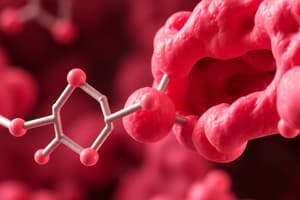Podcast
Questions and Answers
Which step in cholesterol synthesis is catalyzed by the rate-limiting enzyme HMG CoA reductase?
Which step in cholesterol synthesis is catalyzed by the rate-limiting enzyme HMG CoA reductase?
- Step 1 (correct)
- Step 2
- Step 3
- Step 4
How many acetyl CoA molecules are needed to make squalene in cholesterol synthesis?
How many acetyl CoA molecules are needed to make squalene in cholesterol synthesis?
- 2 acetyl CoA
- 6 acetyl CoA
- 3 acetyl CoA (correct)
- 1 acetyl CoA
Which enzyme is the main regulatory step of cholesterol synthesis?
Which enzyme is the main regulatory step of cholesterol synthesis?
- Isopentenyl pyrophosphate
- HMG CoA reductase (correct)
- Farnesyl pyrophosphate
- Mevalonate
Which molecule promotes the de-phosphorylation and activation of HMG CoA reductase?
Which molecule promotes the de-phosphorylation and activation of HMG CoA reductase?
Which molecule promotes the phosphorylation and inhibition of HMG CoA reductase?
Which molecule promotes the phosphorylation and inhibition of HMG CoA reductase?
High intracellular levels of cholesterol (increase/decrease) the transcription of HMG CoA reductase gene.
High intracellular levels of cholesterol (increase/decrease) the transcription of HMG CoA reductase gene.
What is the name of the enzyme that catalyzes the conversion of mevalonate into activated isoprenes in cholesterol synthesis?
What is the name of the enzyme that catalyzes the conversion of mevalonate into activated isoprenes in cholesterol synthesis?
What is the final step in cholesterol synthesis, where linear squalene is converted into the cyclic structure of cholesterol?
What is the final step in cholesterol synthesis, where linear squalene is converted into the cyclic structure of cholesterol?
Which molecule is immediately removed during the conversion of mevalonate into activated isoprenes in cholesterol synthesis?
Which molecule is immediately removed during the conversion of mevalonate into activated isoprenes in cholesterol synthesis?
What is the name of the enzyme that catalyzes the condensation of 6 activated isoprene units to form squalene in cholesterol synthesis?
What is the name of the enzyme that catalyzes the condensation of 6 activated isoprene units to form squalene in cholesterol synthesis?
Which class of lipids is cholesterol classified as?
Which class of lipids is cholesterol classified as?
Which organs of the body contribute most significantly to cholesterol synthesis?
Which organs of the body contribute most significantly to cholesterol synthesis?
Where does cholesterol synthesis occur inside the cell?
Where does cholesterol synthesis occur inside the cell?
Which enzyme plays a key regulatory role in cholesterol synthesis?
Which enzyme plays a key regulatory role in cholesterol synthesis?
What are the basic steps of cholesterol synthesis?
What are the basic steps of cholesterol synthesis?
What is the role of HMG CoA reductase in cholesterol synthesis?
What is the role of HMG CoA reductase in cholesterol synthesis?
What inhibits HMG CoA reductase in cholesterol synthesis?
What inhibits HMG CoA reductase in cholesterol synthesis?
Which class of lipids are based on fatty acid structure?
Which class of lipids are based on fatty acid structure?
What is the structural unit in isoprenoids?
What is the structural unit in isoprenoids?
What is the term for steroids with a hydroxy group at C3?
What is the term for steroids with a hydroxy group at C3?
Flashcards are hidden until you start studying
Study Notes
Cholesterol Synthesis Overview
- HMG CoA reductase catalyzes the rate-limiting step in cholesterol synthesis.
- A total of six acetyl CoA molecules are needed to produce one molecule of squalene.
- HMG CoA reductase serves as the main regulatory enzyme in cholesterol synthesis.
Regulation of HMG CoA Reductase
- Insulin promotes the de-phosphorylation and activation of HMG CoA reductase.
- Glucagon promotes the phosphorylation and inhibition of HMG CoA reductase.
- High intracellular cholesterol levels decrease the transcription of the HMG CoA reductase gene.
Enzymatic Conversions in Cholesterol Synthesis
- The enzyme that converts mevalonate into activated isoprenes is mevalonate kinase.
- Squalene is formed from the condensation of six activated isoprene units; the enzyme responsible for this is squalene synthase.
- During the conversion of mevalonate into activated isoprenes, carbon dioxide is immediately removed.
Final Steps of Cholesterol Synthesis
- The final step in cholesterol synthesis involves converting linear squalene into the cyclic structure of cholesterol via lanosterol.
- Cholesterol is classified as a sterol, a type of lipid related to steroids.
Organs and Cellular Location
- The liver and intestines contribute most significantly to cholesterol synthesis in the body.
- Cholesterol synthesis occurs in the cytoplasm of cells.
Key Points on Lipid Classes and Structures
- HMG CoA reductase plays a key regulatory role in the synthesis of cholesterol.
- Basic steps of cholesterol synthesis include the formation of squalene, conversion to lanosterol, and final transformation into cholesterol.
- HMG CoA reductase is inhibited by statins and other cholesterol-lowering drugs.
- Fatty acids are the structural basis for a different class of lipids known as acyl lipids.
- The structural unit in isoprenoids is the isoprene unit.
- Steroids possessing a hydroxy group at carbon 3 are referred to as sterols.
Studying That Suits You
Use AI to generate personalized quizzes and flashcards to suit your learning preferences.




